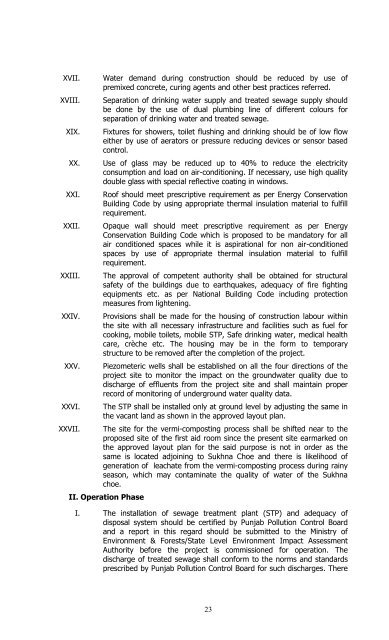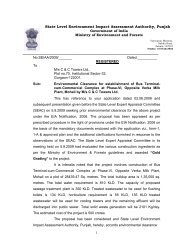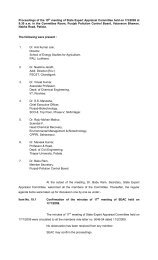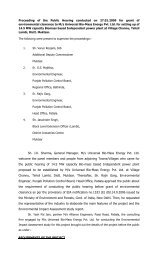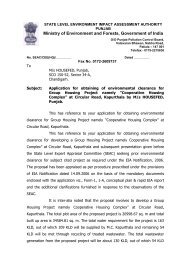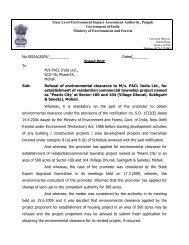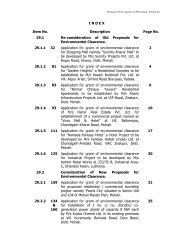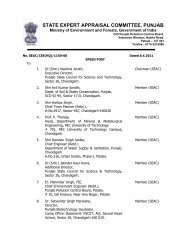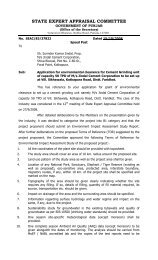20-05-2011 - State Level Environment Impact Assessment Authority ...
20-05-2011 - State Level Environment Impact Assessment Authority ...
20-05-2011 - State Level Environment Impact Assessment Authority ...
You also want an ePaper? Increase the reach of your titles
YUMPU automatically turns print PDFs into web optimized ePapers that Google loves.
XVII.<br />
XVIII.<br />
XIX.<br />
XX.<br />
XXI.<br />
XXII.<br />
XXIII.<br />
XXIV.<br />
XXV.<br />
XXVI.<br />
XXVII.<br />
Water demand during construction should be reduced by use of<br />
premixed concrete, curing agents and other best practices referred.<br />
Separation of drinking water supply and treated sewage supply should<br />
be done by the use of dual plumbing line of different colours for<br />
separation of drinking water and treated sewage.<br />
Fixtures for showers, toilet flushing and drinking should be of low flow<br />
either by use of aerators or pressure reducing devices or sensor based<br />
control.<br />
Use of glass may be reduced up to 40% to reduce the electricity<br />
consumption and load on air-conditioning. If necessary, use high quality<br />
double glass with special reflective coating in windows.<br />
Roof should meet prescriptive requirement as per Energy Conservation<br />
Building Code by using appropriate thermal insulation material to fulfill<br />
requirement.<br />
Opaque wall should meet prescriptive requirement as per Energy<br />
Conservation Building Code which is proposed to be mandatory for all<br />
air conditioned spaces while it is aspirational for non air-conditioned<br />
spaces by use of appropriate thermal insulation material to fulfill<br />
requirement.<br />
The approval of competent authority shall be obtained for structural<br />
safety of the buildings due to earthquakes, adequacy of fire fighting<br />
equipments etc. as per National Building Code including protection<br />
measures from lightening.<br />
Provisions shall be made for the housing of construction labour within<br />
the site with all necessary infrastructure and facilities such as fuel for<br />
cooking, mobile toilets, mobile STP, Safe drinking water, medical health<br />
care, crèche etc. The housing may be in the form to temporary<br />
structure to be removed after the completion of the project.<br />
Piezometeric wells shall be established on all the four directions of the<br />
project site to monitor the impact on the groundwater quality due to<br />
discharge of effluents from the project site and shall maintain proper<br />
record of monitoring of underground water quality data.<br />
The STP shall be installed only at ground level by adjusting the same in<br />
the vacant land as shown in the approved layout plan.<br />
The site for the vermi-composting process shall be shifted near to the<br />
proposed site of the first aid room since the present site earmarked on<br />
the approved layout plan for the said purpose is not in order as the<br />
same is located adjoining to Sukhna Choe and there is likelihood of<br />
generation of leachate from the vermi-composting process during rainy<br />
season, which may contaminate the quality of water of the Sukhna<br />
choe.<br />
II. Operation Phase<br />
I. The installation of sewage treatment plant (STP) and adequacy of<br />
disposal system should be certified by Punjab Pollution Control Board<br />
and a report in this regard should be submitted to the Ministry of<br />
<strong>Environment</strong> & Forests/<strong>State</strong> <strong>Level</strong> <strong>Environment</strong> <strong>Impact</strong> <strong>Assessment</strong><br />
<strong>Authority</strong> before the project is commissioned for operation. The<br />
discharge of treated sewage shall conform to the norms and standards<br />
prescribed by Punjab Pollution Control Board for such discharges. There<br />
23


